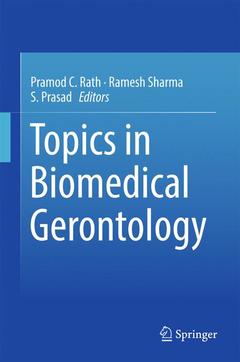Topics in Biomedical Gerontology, Softcover reprint of the original 1st ed. 2017
Coordonnateurs : Rath Pramod C., Sharma Ramesh, Prasad S.

This book presents a collection of articles on various aspects of current research on aging. These include model systems, cellular, biochemical and molecular aspects of experimental aging research, as well as selected intervention studies on age-related diseases.
Aging is a global challenge to human society. Children are always in a hurry to become adults, while adults produce offspring and add to the gene pool. However, after adulthood or the attainment of reproductive maturity, all physiological parameters of the living organism start to undergo the aging process. Old age sets in slowly but surely, and usually continues for a prolonged period. If vigor and vitality are the main advantages of adulthood, old age offers the rewards of experience and maturity.
Biologists ask questions such as: Why do we age? How do we become old? Is it possible to slow down, postpone or even prevent aging? In turn, medical experts ask: What are the diseases associated with old age? Arethere medicines that can help affected elderly patients? In fact both groups are asking themselves how can we add more health to old age.
Healthy aging is the dream of every individual. But to achieve this, it is fundamental that we first understand the cellular, biochemical and molecular basis of the aging process in mammalian cells, tissues and intact living organisms, which can serve as experimental model systems in Biomedical Gerontology. Once the biology of aging is understood at the genetic and molecular levels, interventional approaches to aging and its associated diseases may be easier to plan and implement at the preclinical level.
Pramod C. Rath is a Professor of Molecular Biology and has been Acting Dean of the School of Life Sciences, Jawaharlal Nehru University, New Delhi. He received his Ph. D. in 1988 from the Biochemistry Section of the Zoology Department, Banaras Hindu University, Varanasi, India on “Expression and Modulation of Genes during Aging of the Rat” under the supervision of Prof. M. S. Kanungo. He did his post-doctoral research at the Institute for Molecular Biology I, University of Zurich, ETH-Hoenggerberg from 1989 to 1990 on “Regulation of Interferon Gene Expression in Mammalian Cells” with Prof. Charles Weissmann, Director. He joined the School of Life Sciences, Jawaharlal Nehru University, New Delhi as an Assistant Professor (Molecular Biology) in December 1990. He went to Cold Spring Harbor Laboratory, New York, as a Short-term Scholar in March, 1998 to work on “Advanced Genome Sequencing and Analysis” with Prof. Richard MacCombie, Chief, Genome Sequencing Research Group. He wasa Visiting Research Scientist during 1998-99 at the University of Texas M. D. Anderson Cancer Center, Houston, Texas and worked on “Cytokine Signalling and Cancer” with Prof. Bharat B. Aggarwal, Chief, Cytokine Research Laboratory. He also went to the Stem Cell Institute, Medical School, University of Minnesota, Minneapolis as a Short-term Scholar during Nov.-Dec., 2005 and worked on “Multipotent Adult Progenitor Cells (MAPCs)” with Prof. Catherine Verfaillie, Director. He has 25 years of teaching and research experience, having mentored 17 Ph. D. and 3 M. Phil. students. He teaches Molecular Biology, Molecular Genetics and Cell Signalling courses at M. Sc. and Pre-Ph. D. levels. His research areas include (i) Genomic Biology of Repetitive DNA and Noncoding RNA; (ii) Cytokines, Transcription Factors, Cell Signalling and Disease and (iii) Mesenchymal Stem Cells from Bone Marrow and Regenerative Medicine. He has many research publications to his credit in reputed international journals,s
Date de parution : 11-2016
Ouvrage de 355 p.
15.5x23.5 cm
Date de parution : 04-2018
Ouvrage de 355 p.
15.5x23.5 cm
